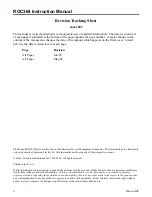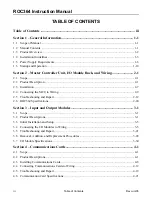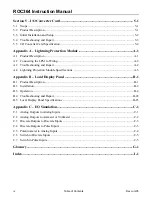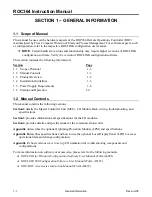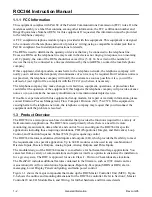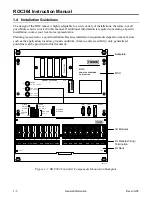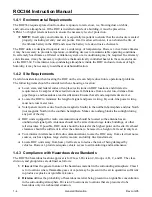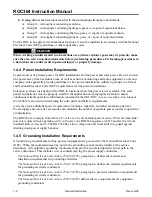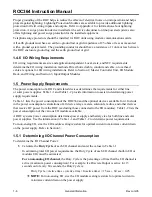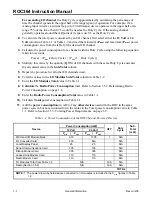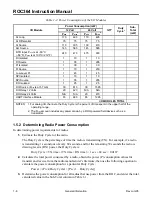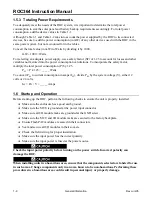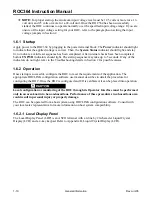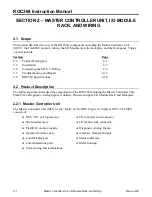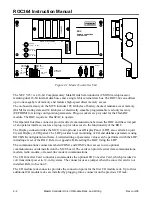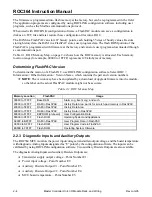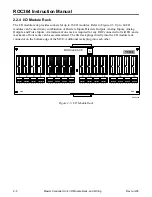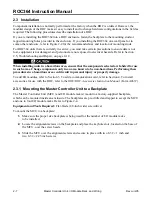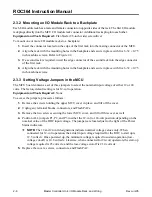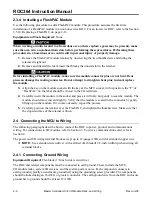
ROC364 Instruction Manual
1-4
General Information
Rev Jun/05
1.4.1 Environmental Requirements
The ROC364 requires protection from direct exposure to rain, snow, ice, blowing dust or debris,
and corrosive atmospheres. If the ROC is installed outside of a building, it must be placed in a
NEMA 3 or higher rated enclosure to ensure the necessary level of protection.
NOTE:
In salt spray environments, it is especially important to ensure that the enclosure is sealed
properly, including all entry and exit points. If salt is allowed to enter, it can shorten the life of
the lithium battery in the ROC and cause the battery to leak corrosive chemicals.
The ROC units are designed to operate over a wide range of temperatures. However, in extreme climates
it may be necessary to provide temperature-controlling devices to maintain stable operating conditions.
In extremely hot climates, a filtered ventilation system or air conditioning may be required. In extremely
cold climates, it may be necessary to provide a thermostatically controlled heater in the same enclosure
as the ROC364. To maintain a non-condensing atmosphere inside the ROC enclosure in areas of high
humidity, it may be necessary to add heat or dehumidification.
1.4.2 Site Requirements
Careful consideration when locating the ROC on the site can help reduce future operational problems.
The following items should be considered when choosing a location:
♦
Local, state, and federal codes often place restrictions on ROC locations and dictate site
requirements. Examples of these restrictions are fall distance from a meter run, distance from
pipe flanges, and hazardous area classifications. Ensure that all code requirements are met.
♦
Locate the ROC to minimize the length of signal and power wiring. By code, line power wiring
must not cross meter runs.
♦
Solar panels must face due South (not magnetic South) in the northern hemisphere and due North
(not magnetic North) in the southern hemisphere. Make sure nothing blocks the sunlight during
any part of the day.
♦
ROC units equipped for radio communications should be located so the antenna has an
unobstructed signal path. Antennas should not be aimed into storage tanks, buildings, or other
tall structures. If possible, ROC units should be located at the highest point on the site. Overhead
clearance should be sufficient to allow the antenna to be raised to a height of at least twenty feet.
♦
To minimize interference with radio communications, locate the ROC away from electrical noise
sources, such as engines, large electric motors, and utility line transformers.
♦
Locate ROC units away from heavy traffic areas to reduce the risk of being damaged by
vehicles. However, provide adequate vehicle access to aid monitoring and maintenance.
1.4.3 Compliance with Hazardous Area Standards
The ROC364 hazardous location approval is for Class I, Division 2, Groups A, B, C, and D. The class,
division, and group terms are defined as follows:
1.
Class
defines the general nature of the hazardous material in the surrounding atmosphere. Class I
is for locations where flammable gases or vapors may be present in the air in quantities sufficient
to produce explosive or ignitable mixtures.
2.
Division
defines the probability of hazardous material being present in an ignitable concentration
in the surrounding atmosphere. Division 2 locations are locations that are presumed to be
hazardous only in an abnormal situation.


